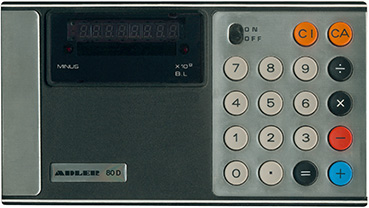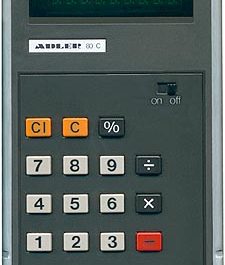
The Adler 80D calculator, also known as the EC 80D, was an early handheld scientific calculator first produced in 1973 or 1974 by the German company T.A Vertriebs. Although largely forgotten today, the Adler 80D was an impressive and substantial machine for its time.
The Adler 80D had a uniquely large and wide horizontal design, measuring 159mm x 90mm x 21.4mm and weighing nearly 200g without batteries. The sturdy black plastic case featured grooved details along the top and bottom edges, an indented display area, and a wrap-around brushed aluminum keyboard frame. Overall, the aesthetic was sleek yet utilitarian.


Inside, the Adler 80D was packed with components, including dozens of resistors, capacitors, and transistors alongside several integrated circuits. This explains the calculator’s relatively large size compared to later models. The main chip was an Omron-branded Hitachi HD32153P CPU packaged in a black plastic 26-pin DIP case.


For output, the Adler 80D utilized a circular 8-digit vacuum fluorescent display—quite advanced for its day. Two additional red LEDs indicated negative numbers and overflow states since the main display could not show minus signs.
As a scientific calculator, the 80D supported the four basic arithmetic operations. It offered automatic constant calculation and full 8-digit negative number capacity. The logic was mostly solid, albeit with some small bugs around negative zero handling. Oddly, the calculator completely locked up with no recovery if divided by zero—a serious flaw.
In summary, the Adler 80D was an ambitious large-format scientific calculator using the latest technology available in the early 1970s. It paved the way for future generations of handheld calculating devices. The 80D’s impressive but quirky design encapsulates the era when electronic calculators were still a marvel of engineering and innovation.
